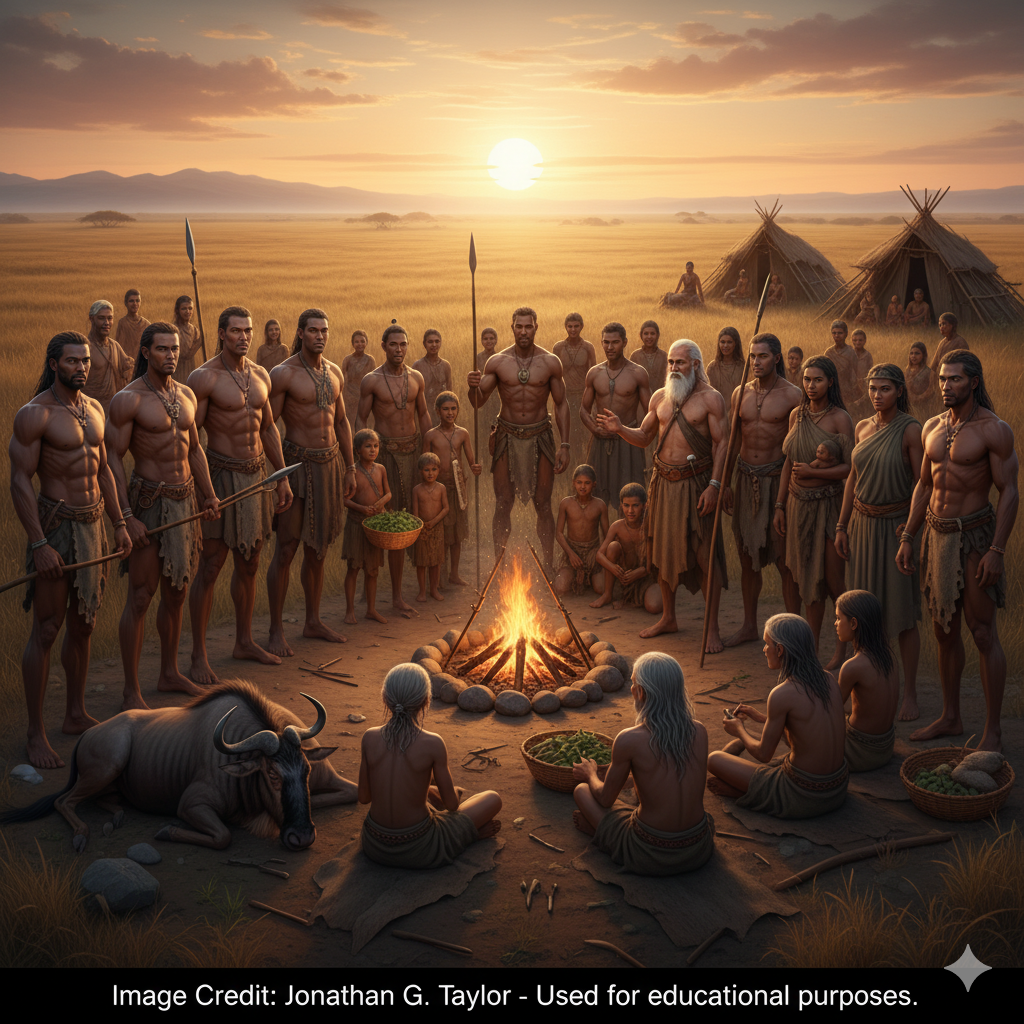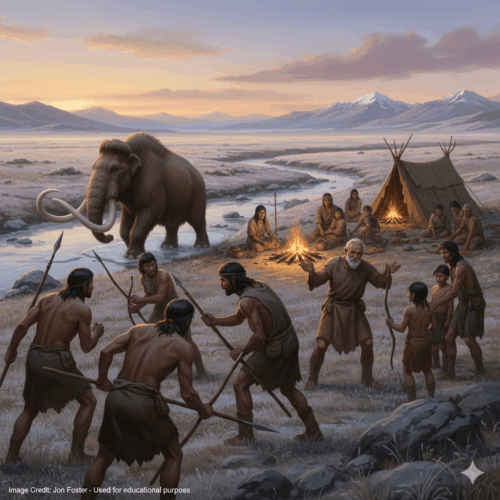The Dawn of Human Communities: Understanding Our Ancient Roots

With AI, robotics, and space exploration defining modern civilization, we stand at a fascinating crossroads. We don’t know exactly where we’re headed, but we should hope for progress. Yet even as we witness rapid technological advancement and increasing societal conservatism, the contrast itself is remarkable. On one side, people struggle to afford basic necessities like decent meals; on the other, we have groups with access to personal medical teams readily available 24/7.
This disparity raises profound questions: Was it always like this? Why did status and hierarchy come to dominate human society?
In order to find answer for these questions, I started this journey back to the very beginning—to the first chapter of the human story.
Hope that, as we explore various aspect of Human Evolution, we may find some answers.
The First Teams: Early Hunter-Gatherer Bands
Long before cities rose or agriculture transformed our world, our ancestors created something extraordinary. Beginning with the “Birth of Tribe” series on human evolution and prehistoric society, we find ourselves examining small groups of roughly 20 to 50 people living as nomads—traveling, exploring, and hunting together.
These early bands represented humanity’s fundamental social unit for the vast majority of our existence. Picture a community where you knew every member intimately, where survival depended on collective effort rather than individual achievement. From Africa’s sun-scorched plains to Europe’s frozen steppes, archaeological evidence reveals a consistent pattern: these groups thrived through shared resources, cooperative childcare, and collective responsibility.
The Power of Meritocracy
In this early society, meritocracy prevailed. Strong, capable individuals could hunt in groups, with women caring for children, gathering herbs and food. These small groups slowly evolved into what we recognize as tribes. Critically, no permanent settlement existed during this period. Tribes traveled as needs dictated, with elders gradually becoming involved in decision-making, helping train young people, settling disputes, and witnessing the emergence of religious ritual.
This marked the first signs of hierarchy formation.
Beyond Survival: Cooperation and Ritual Bind Communities
Cooperation extended far beyond practical necessity. Hunting large game like mammoths or bison demanded precise, coordinated strategies that showcased humanity’s capacity for complex planning. Meanwhile, gathering—primarily undertaken by women—provided consistent calories that sustained groups between hunts, creating a balanced subsistence strategy.
Yet their connections transcended mere practicality. Cave paintings at Lascaux (approximately 17,000 years old) and Chauvet-Pont-d’Arc (dating to 36,000 years ago) weren’t simply art—they likely formed integral parts of spiritual ceremonies strengthening communal bonds. Similarly, burials at Qafzeh, Israel (circa 100,000 years ago) with grave goods suggest beliefs in an afterlife and profound emotional connections.
These shared experiences through storytelling, dance, and ritual forged powerful communal identities that would influence human society for millennia.
The Egalitarian Blueprint: A Radically Different Social Structure
Perhaps most striking to modern eyes, these early communities were largely egalitarian. No kings, permanent chiefs, or rigid social classes existed. Leadership remained fluid, based on merit, skill, and wisdom rather than inherited status.
The best hunter might lead during a chase, while experienced elders guided group decisions or resolved conflicts. Modern studies of the San people of southern Africa [3] and Hadza of Tanzania [4] confirm this pattern: decisions emerged through consensus, resources were shared to ensure everyone’s survival, and respect—not wealth accumulation—determined status.
Key Characteristics Defining Early Human Communities
The earliest societies shared distinct features:
- Foraging Economy: Complete dependence on hunting wild game and gathering plant foods for sustenance.
- Mobile Lifestyle: Nomadic or semi-nomadic movement patterns following seasonal food sources across diverse terrains.
- Resource Sharing: Tools, food, and knowledge functioned as communal assets rather than private property.
- Social Cohesion: Strong bonds maintained through oral storytelling traditions, shared rituals, and evolving cultural practices.
- Merit-Based Leadership: Influence earned through demonstrated experience and ability, never through inherited power or wealth.
Archaeological Windows into Deep Time
Remarkable sites illuminate this ancient world:
Blombos Cave, South Africa
Blombos Cave, South Africa: Ochre engravings dating approximately 75,000 years ago [1] represent some of humanity’s earliest evidence of symbolic thought, demonstrating sophisticated cognitive complexity.
Göbekli Tepe, Turkey
Göbekli Tepe, Turkey: Dating to roughly 11,600 years ago (around 9,600 BCE) [2], this site’s massive stone pillars predate agriculture, suggesting hunter-gatherers built complex ritual centers driven by spiritual rather than agricultural motivations—challenging traditional narratives about civilization’s origins.
The Evolution Beyond Bands: Clan Systems and Settlement
This tribal structure developed further forms in some civilizations. Among clan systems, family clans became predominant examples. These families rarely accepted discipline from outside worlds, and even marriage with clan descendants required adherence to clan rules and regulations, with patriarchs generally acting as leaders assisted by groups of elders.
Eventually, tribal settlement evolved into villages and towns. Humanity entered the era of city-states, where some city-states conquered others, formed alliances, and later entered the era of kingdoms and empires, which eventually evolved into countries.
Significantly, nomadic tribes remained prevalent in certain regions like the Americas, Africa, and Australia well into the 20th century, adapting their traditional lifestyles in the face of expansion by agrarian societies and nation-states.
Modern Forces: Colonization, Urbanization, and Globalization
Today, colonization, urbanization, and globalization represent various terms for civilization’s downfall. This raises profound questions about how we reached this point and why status began dominating merit.
The Enduring Legacy of Human Communities
Though separated by tens of thousands of years, these early communities shaped our social DNA. Their reliance on cooperation, shared identity, and egalitarian principles laid foundations for all human civilization. By understanding their world—its challenges, innovations, and social structures—we gain invaluable insight into both our origins and our potential futures.
As we navigate modern complexities of inequality and technological change, perhaps we can learn from our ancestors’ emphasis on collective survival, merit-based leadership, and shared responsibility. The story of humanity begins not with kings or cities, but with small bands of cooperating individuals who discovered that together, they could not only survive but thrive.
References and Further Reading:
- Henshilwood, C. S., et al. (2002). “Emergence of Modern Human Behaviour: Middle Stone Age Engravings from South Africa.” Science, 295(5558), 1278-1280. (Relevant to Blombos Cave)
- Schmidt, K. (2010). “Göbekli Tepe – the Stone Age Sanctuaries.” Documenta Praehistorica, 37, 239-256. (Relevant to Göbekli Tepe)
- Lee, R. B. (1979). The !Kung San: Men, Women and Work in a Foraging Society. Cambridge University Press. (Relevant to San people)
- Marlowe, F. W. (2010). The Hadza: Hunter-Gatherers of Tanzania. University of California Press. (Relevant to Hadza people)
This evolution journey will be discussed in later chapters as we trace humanity’s path from nomadic bands to complex civilizations.

